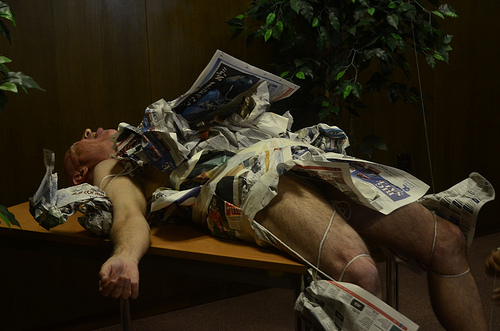In January 2013, Polak celebrated the 20th year of Israel’s involvement by curating an exhibition at Mitzpe Ramon in the Negev, the same desert town where he exhibited “Coexistence,” the first Israeli International Artists Museum show, in 1995. The new show later moved to the 92nd Street Y in Manhattan for a six-week run.
“Since 1994, my principal role is trying to give exposure to Israeli artists,” Polak says.
He arranges five or six exhibitions each year in 25 countries. Following the Mitzpe Ramon anniversary show, he went to Prague and Vienna with “Artists: Messengers of Peace,” sponsored by the Israeli pharmaceuticals company Dr. Fischer.
“Almost every month I’m somewhere else,” he says. “In the spring I will bring 10 Israeli artists to Pune, India, to work with13 young girls in an orphanage to make a sculpture garden of recycled materials.”
This latter project is Polak’s own. A versatile and prolific professional, he has curated 300 Israeli exhibitions; founded a fringe theater group; produced more than 100 short videos on Israeli artists with his son-in-law, Eran Gil; and wrote more than 200 articles, 100 professional catalogs and three plays.
He produces public art events for many Israeli municipalities and does festivals and trade shows for clients including IBM, the National Lottery, the Tourism Ministry, Bank Leumi, Sheba Medical Center and Givatayim Theater.
Givatayim, the Tel Aviv bedroom suburb where Polak was born in 1953, is still his home and, more recently, his workplace.
Combining past and future
The studio where Polak has worked since 2006 is housed in a historic building where Givatayim’s first waterworks was built in 1927, and where local citizens clandestinely made weapons for the coming War of Independence. He wanted to use the neglected site as a new rehearsal venue for Tara, his 30-year-old drama troupe that gives free public performances on social issues.
The municipality gave Polak the space and he turned part of it into a gallery to display his own and other artists’ works. Groups of students and adults often come to tour the place, and Polak tells them about the waterworks, the weapons and the art.
“I adopted [spiritual Zionism visionary] Ahad Ha’am’s philosophy that without the past we do not have a future and without the future we don’t have a past. You have to combine them all the time. Really, this is what I am doing,” says Polak.
This philosophy also is evident in two of his most cherished long-term projects: recycled art workshops, and “Bodies,” his decade-long work in which he uses his own nude body to provide a different perspective on the Holocaust.
In some ways the two projects intersect. Newspaper, one of his favored recyclables, is used in his hands-on workshops for kids and also in many of his “Bodies” images.

The artist covered in newspaper at a Prague exhibition. Photo by Varda Carmeli
Dialogue with creativity
“I was always fascinated with newspapers,” Polak says. As a child, he produced his own neighborhood newspaper, Oren, after the oren (pine) tree in his own backyard.
In other “Bodies” photos, taken in his studio and in other international cities, Polak’s naked form might be covered with flour, Dead Sea mud or nothing at all. It might be a human screen for his father’s autobiographical Holocaust film.
In fact, “Bodies” is really all about his lifelong quest to get at the heart of his father, Moshe, now in his nineties. The two men are close, and as a second-generation survivor, Polak feels a measure of his father’s emotional scars.
“Being a victim is something I want to analyze with my own naked body,” Polak says. “I want to analyze what it is to be standing naked in front of a soldier in terrible cold, and I want people to understand that nature was a witness.”
On the floor of his studio there is a pile of leaves he collected last year in the Rambola Forest in Riga, the Latvian city where the Nazis murdered his grandmother and other relatives. Several “Bodies” photos were taken in that same forest.
“When we talk about the Holocaust, most people are fed up with the usual images -- they don’t feel anymore -- so we need to find an updated means to bring out those feelings,” he explains.
Now a grandfather, Polak also has a wider mission. “I want to bring more people into a dialogue with creativity. I want to convince more businesses and organizations to use art and creative processes to change minds and policies. My own experience is that you don’t need a lot of means to achieve an understanding of people.”